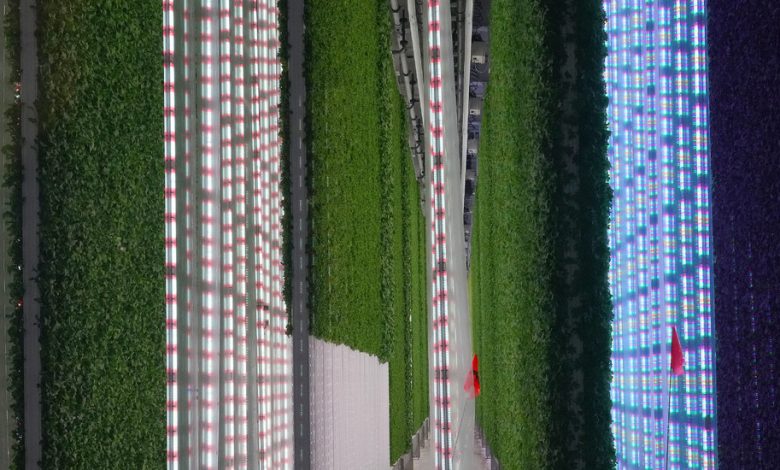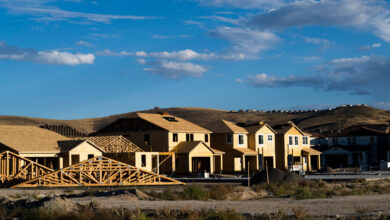Vertical Farms Expand as Demand for Year-Round Produce Grows

A recently constructed 95,000-square-foot warehouse in Compton, Calif., ticks off all the boxes for the booming storage industry: 32-foot-high ceilings, a secure truck court and access to truck routes.
But it won’t be used for cargo or storage. Plenty Unlimited, an agricultural start-up based in San Diego, is using the site for an indoor vertical farm, expected to open later this year.
“It’s the ability to put production anywhere without considering climate,” said Arama Kukutai, the company’s chief executive. The lease terms were not disclosed, according to Kidder Mathews, a commercial real estate firm on the West Coast. Vacancy rates in the area are about 0.6 percent.
Plenty Unlimited supplies Albertsons grocery stores with lettuce varieties grown on a smaller-scale farm outside San Francisco. Walmart, an investor, will soon sell Plenty’s produce throughout California. And Plenty has aspirations beyond greens: Last month, it announced plans with Driscoll’s, a berry seller, to develop an indoor farm in the Northeast devoted to strawberries.
At a time when supply chain disruptions continue to slow distribution, consumers embrace healthy eating habits and climate change is expected to affect crop yields, a practice known as controlled-environment agriculture, including indoor vertical farms relying on artificial light and technology, is attracting venture capitalists.
But the industry faces challenges, including high costs for energy, technological limitations and the ability to scale production to keep expenses down.
Agriculture in a controlled environment has been around since the 1970s, said Gene A. Giacomelli, a professor of biosystems engineering at the University of Arizona. What made moving indoors possible was a drop in price in LED lights, which plunged as much as 94 percent in 2015 from 2008.
The term vertical farm was popularized by Dickson Despommier, a professor emeritus of environmental health sciences at Columbia University. Vertical farming is expected to grow to $9.7 billion worldwide by 2026, from $3.1 billion in 2021, according to ResearchAndMarkets.com, a data analysis firm. Pitchbook, a financial data and software company in Seattle, tracked 33 deals worth nearly $960 million in 2021, up from $865 billion the year before and $484 million in 2019.
AppHarvest, a greenhouse grower, recently went public via a merger with Novus Capital. And in August, BrightFarms, another greenhouse operator, was acquired by Cox Enterprises in Atlanta.
Scientists caution that technology has limitations, with LED lights, sensors and operating systems adding to utility costs. “They don’t want to be warehouses, they want to be food production facilities,” Professor Giacomelli said. “And food production facilities have never had this kind of money.”
The money is creating demand for warehouse space. Kalera, a vertical farm company based in Orlando, Fla., harvests greens and culinary herbs there and in Houston and Atlanta. Farms in Denver, Seattle, Honolulu and St. Paul are opening later this year, and one in Columbus, Ohio, is planned for 2023. Farms are also open in Munich and Kuwait.
Details are hard to come by because the farms closely guard their intellectual property, growing system designs, material and structures.
“Everyone has their own secret sauce,” said Brent de Jong, chairman and chief executive of Agrico Acquisition Corporation, which in January announced a merger with Kalera.
But as long as the building being used as a vertical farm meets height criteria and avoids high utility costs, “there’s no limit where I can put a farm,” said Austin Martin, Kalera’s chief operating officer.
The basic requirements for vertical farm warehouses include access to major highways, a one-day drive to major population centers and an educated work force that understands automation and plant science.
“The factory for leafy greens and micro greens production is similar to a semiconductor factory providing a controlled environment to predictably manufacture on an automated basis its products,” Mr. de Jong said in an email.
Plants are stacked in vertical rows reaching heights of 30 feet or more, said Neil Mattson, a horticulture professor at Cornell. Additional space is reserved for aisles, harvesting and packing, but there are no common metrics or industry standard.
One example of how controlled-environment agriculture is transforming industrial space is evolving in Pennsylvania, which serves markets from Boston to Richmond, Va.
Bowery Farming, which is based in Manhattan, is outfitting a 150,000-square-foot farm on the site of a former steel plant in Bethlehem, Pa., that is scheduled to open in May.
Bowery also has three farms in Kearny, N.J., two of which are for research and development. The third is a commercial operation serving grocers and e-commerce companies in the Northeast. Another facility, in Nottingham, Md., runs on hydroelectric energy. And the company has announced plans to expand near Atlanta and in the Dallas-Fort Worth area.
“It’s all about speed to market,” said Hans Tung, a managing partner at GGV Capital, formerly Granite Global Ventures, an investor in Bowery Farming.
Darren Thompson, Bowery’s chief financial officer, said he expected Bowery’s new farms to be similar in size to the one in Bethlehem. “Having too many differences from farm to farm hurts my ability to drive costs,” he said.
The Bethlehem site has heavy power support, sewer and water capacity and fiber-optic cable, said Peter Polt, an executive vice president of J.G. Petrucci Company, which built the shell of the building and office space. “But the tenant outfitted the building for the grow process,” he added.
Developers also request proximity to food distribution centers to save on transportation costs, said Brent Vernon, executive director of the Pennsylvania governor’s action team, which works to bring businesses to the state. And he said state funding and grants are evaluated based on factors including brownfield redevelopment, unemployment rates and the potential for job creation.
Bowery will create and retain at least 70 full-time jobs within the next three years and pledged to invest at least $32 million, Pennsylvania officials said.
Upward Farms, a start-up based in Brooklyn that blends vertical farming with aquaponics and uses fish waste as fertilizer, is building a 250,000-square-foot warehouse on six acres in Luzerne County, Pa., about 100 miles from Manhattan.
Local production is better because it brings leafy greens closer to the retailer and the consumer, said Jason Green, the president and chief executive of Upward.
Further west, in Selinsgrove, is a 280,000-square-foot greenhouse that belongs to BrightFarms. That company has begun developing five new greenhouses that will be 10 times that size, said Steve Platt, the chief executive of BrightFarms.
Reaching a scale that will be sustainable for businesses may mean expanding the types of crops grown in vertical systems, from leafy greens to vine and fruiting crops, said Russell Redding, the Pennsylvania agriculture secretary. For example, Bowery Farming announced plans to distribute strawberries in limited release in New York.
But some scientists have doubts about the industry’s ability to scale and diversify given the limitations of current technology. Tomatoes take 60 percent more electricity to grow than lettuce, and strawberries take twice that amount, said Bruce Bugbee, director of the Crop Physiology Laboratory of Utah State University in Logan.
“LED lights are about 70 percent, close to their theoretical maximum” of efficiency, he said. The consumer is paying for the energy costs.
Morgan Pattison, president of Solid State Lighting Services in Johnson, Tenn., and an adviser to the Department of Energy, was more blunt. “LED’s are not going to go down much more” in cost, he said. “Where investors are going against physics, they are going to have a hard time.”
Source link






